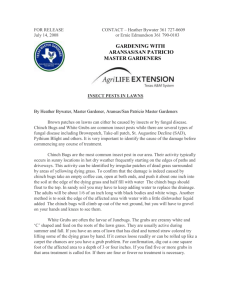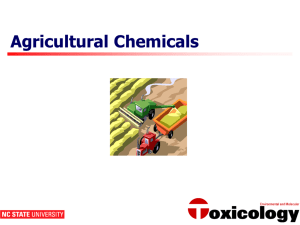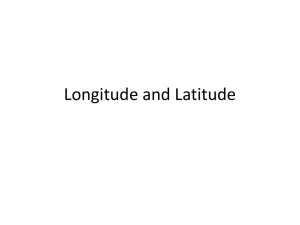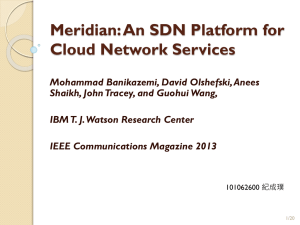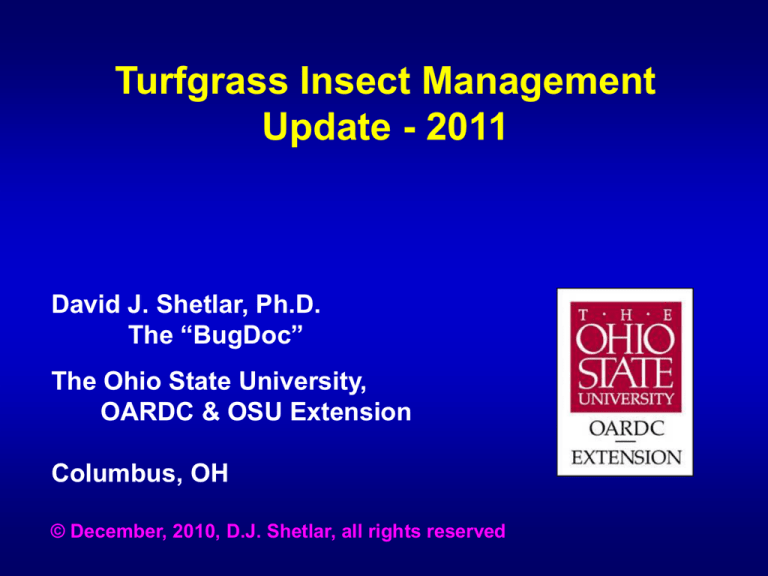
Turfgrass Insect Management
Update - 2011
David J. Shetlar, Ph.D.
The “BugDoc”
The Ohio State University,
OARDC & OSU Extension
Columbus, OH
© December, 2010, D.J. Shetlar, all rights reserved
Notes:
In this turfgrass insect update for 2011, I want to cover the
following topics:
•
•
•
•
•
•
•
Where to get current information and assistance
Introduction of new and newer insecticides
Performance of White Grub insecticides
Performance of Turf Caterpillar insecticides
Performance of Hairy Chinch Bug insecticides
Performance of Bluegrass Billbug insecticides
And the “good story” about turfgrass insecticides!
http://buckeyeturf.osu.edu
Notes:
At Ohio State, the Turfgrass Team is very proud of our
BuckeyeTurf web site! During the growing season, there
are postings virtually every day in response to questions
and from various team members on what we are seeing in
the field. There are educational podcasts, often in several
languages and tons of other information. Karl Danneberger
leads the group, but other turfgrass agronomists like John
Street and Dave Gardner post items. Pam Sherratt tends
to the sport turf sections. Joe Rimelspach often comments
on turf diseases and other maladies that he has seen
during his travels across the state and on specimens
submitted to the diagnostic clinic. From entomology, I often
comment on insect activity as does Parwinder Grewal and
Harry Niemczyk. Be sure to bookmark this site or sign up
for notifications of new postings.
http://bygl.osu.edu
Notes:
I find that many turf managers have missed finding out
about another popular web site that is operated by Ohio
State “green industry” folks! It is the Buckeye Yard and
Garden onLine which we call the BYGL (pronounced
beagle). From April through October, anywhere from 15 to
30 extension specialists, researchers, county agents and
industry reps have a phone conference every Tuesday
morning. We discuss what we are seeing across Ohio in
our landscapes, at garden centers, in nurseries and
requests for information that are coming in the various
offices. Certain members take notes, write them up and
look for factsheets and other postings that are relevant.
This is then posted on Thursday by noon. This is another
MUST VISIT web site for anyone taking care of turf!
The P.E.S.T. Newsletter
available from:
Ohio Nursery &
Landscape Association
72 Dorchester Square
Westerville, OH 43081
614-899-1195
800-825-5062
http://www.onla.org/
Notes:
I must also put in a pitch for my own newsletter! This was
developed through a collaboration with the Ohio Nursery &
Landscape Association as a subscription service to Ohio’s
Green Industries. I produce this every other week from
mid-March through mid-October. You can order a
subscription by contacting the ONLA office and be sure to
mention if you are a member of one of Ohio’s green
industries (ONLA, OTF, OLCA, etc.) in order to get a
discount. You can receive the newsletter by mail, but it is
also delivered by email as a PDF file and there is a web
site that has color pictures, links to relevant sites, etc.
Profits from this effort go back into our Ohio State
University Extension operating funds! Thanks for your
support!
Notes, cont’d:
Provaunt is also from DuPont and represents another
insecticide mode of action. The mode of action is similar to
that of pyrethroids, but different enough that pyrethroidresistant insects still respond to Provaunt. It is primarily used
for caterpillar control, but we are seeing significant billbug
and annual bluegrass weevil control also.
Duocide is a combination product from an Ohio company,
The Andersons. It uses carbaryl (Sevin) plus bifenthrin
(Talstar) and because both of these compounds are off
patent, the product is relatively inexpensive! The carbaryl
provides soil and surface insect control while the bifenthrin is
great for knocking down caterpillars and chinch bugs.
Zylam is a new product from PBI Gordon that contains
dinotrfuran (a water-soluble neonicotinoid), the active
ingredient of Safari. We are still finding out its fit in turf, but
we have seen good control of caterpillars and billbugs.
•
•
•
•
New Insecticides
Acelepryn™ (=E2Y45 or chlorantraniliprole, a
new insecticide category from DuPont) –
excellent grub & caterpillar control, long lasting;
also good on billbugs & chinch bugs.
Provaunt™ (=Indoxacarb, a new insecticide
category from DuPont) – excellent caterpillar
control, but active against weevil adults.
Duocide™ (=carbaryl plus bifenthrin from The
Andersons) – good grub control with curative
action; also good on turfgrass surface insects.
Zylam™ (=dinotefuran from PBI Gordon)
Notes:
Acelepryn is a new insecticide from DuPont and it is the first
one I’ve seen that has received a true Category 4
designation from EPA! The label states at the bottom, “EPA
has determined: signal word not necessary.” That’s right,
there is no “Caution” or “Warning” on this label! This
insecticide exploits a unique way that insect muscles utilize
calcium in muscle contractions. Humans, birds, fish, and
other animals don’t use this calcium utilization mechanism,
so it has virtually no affect on us or these other non-targets!
In our studies, Acelepryn has performed very well against
white grubs even with April applications! It also has a
distinction of providing season-long cutworm and sod
webworm control! All this at reduced rates of 0.1 to 0.2
pounds of active per acre! More later!
Cont’d
Other Newer Insecticides
•
Meridian™ (=thiamethoxam, new neonicotinoid
from Syngenta) – excellent grub control, long
lasting, etc. – Registration received in February
2007.
•
Arena™ (=clothianidin, a new neonicotinoid from
Valent) – excellent grub control, long lasting,
good curative action on billbugs and white grubs.
•
Aloft™ (=clothianidin plus bifenthrin) – new
combo product from Arysta with excellent broad
spectrum activity and rapid knock-down of
surface insects.
Notes:
The following insecticides are not really recent introductions,
but are “newer” products!
Meridian is another neonicotinoid (the same category as
imidacloprid or Merit). Frankly, it has performed very much
like Merit in our studies!
Arena and Aloft contain the final neonicotinoid that is
registered for turfgrass usage. In our studies and those of
others, clothianidin has been the most active of the neonics
in turf! It has broad spectrum with excellent control of white
grubs, billbugs, and chinch bugs. There is even some good
caterpillar control. In late season studies, clothianidin has
given us very good control of big, fat, and sassy third instar
white grubs. Compared to Dylox which kills grubs in 2 to 3
days, clothianidin kills the grubs in 3 to 5 days! The
combination product, Aloft, provides even faster knock down
of chinch bugs and turf caterpillars.
Ranked Efficacy of White Grub Insecticides
1976 – 2008a
Insecticide
Carbaryl
(=Sevin)
rate
ave
range
lb.ai./a. % control # tests % control
8.0
72.8
43
13-100
% of tests
below 70%
40
Cl-antraniliprole 0.1
(=Acelepryn)
0.2
93.9
98.9
11
7
70-100
89-100
0
0
Clothianidin
(=Arena)
0.25
0.3
94.7
99.5
3
4
90-100
99-100
0
0
Halofenozide
(=MACH2)
1.5
2.0
91.2
89.6
65
53
10-100
56-100
12
9
Imidacloprid
(=Merit)
0.3
0.4
94.1
94.1
88
7
58-100
82-100
6
0
Permethrin
0.26
31.8
8
0-54
100
Thiamethoxam
(=Meridian)
0.2
96.1
38
0-100
3
Trichlorfon
8.0
(=Dylox, Proxol)
77.6
91
0-98
19
a
Data from ESA publications (1977-2008) & Ohio testing using masked chafer and Japanese beetle data where
label timing recommendations were used and at least 4.0 grubs per sq.ft. were found in checks.
Notes:
The grub efficacy table is the one everyone seems to want to
see, but be careful interpreting the data! In reality, there is not
significant difference in performance at the plus or minus 10%
level! This means that Acelepryn, Arena/Aloft, MACH2, Merit
and Meridian are not significantly different in performance!
Likewise, Sevin and Dylox are similar to each other in
performance. I often joke that, while Permethrin is registered
for grub control, and is one of the most commonly used
products by homeowners, the only real way you can kill grubs
with this product is to pull back the dead turf and drop the bag
on the grubs!
The data in this table are from studies where the insecticides
were applied at the “ideal” time – July into mid-August.
Japanese Beetle Annual Cycle
JAN FEB MAR APR MAY JUN JUL AUG SEP OCT NOV DEC
Preventive-Early Curative Timing
Traditional Control Timing
Notes:
It’s often difficult to change how people use grub controls. In
the 1980s and 1990s, grub controls only worked for 20 to 30
days or even less (represented by the pink bar). Our
neonicotinoid insecticides and Acelepryn are known to have
effective residuals of 60 to 90 days (even more with
Acelepryn!), so this opens up the possibility of using the
products over a wider window (represented by the yellow
bar).
So, are there data for these time periods?
Comparison of Grub Insecticide Efficacy
by Time of Application
Insecticide
Clothianidin
(=Arena)
rate
lb.ai./a.
0.25
0.3
May
ave % control (#tests)
June
July
to Aug 16
100.0 (1) 90.0 (1)
93.0 (1) 100.0 (2)
to Sept 10
97.0 (2)
99.0 (2)
-----
--97.0 (1)
91.6 (2)
98.2 (5)
-----
-----
Cl-antraniliprole
0.1
(=Acelepryn) 0.2
92.8 (4)
94.8 (4)
93.3 (9)
99.8 (4)
Halofenozide
(=MACH2)
1.5
2.0
88.5 (8)
80.5 (4)
94.4 (23) 88.8 (21) 89.6 (19)
63.7 (9) 93.8 (12) 75.0 (5)
77.7 (27)
---
Imidachloprid
(=Merit)
0.3
0.4
74.4 (12) 91.3 (27) 94.7 (39) 93.6 (29)
62.0 (1) 88.0 (1) 89.0 (1) 82.0 (1)
94.1 (35)
---
Thiamethoxam
(=Meridian)
0.2
0.26
80.0 (5)
91.5 (4)
Trichlorfon
8.0
a
---
98.8 (11) 98.6 (9) 98.3 (11)
99.3 (3) 99.3 (2) 98.0 (6)
---
---
62.2 (5)
93.7 (8)
100.0 (4)
77.7 (19)
Data from ESA publications (1977-2008) & Ohio testing using masked chafer and Japanese beetle data where
label timing recommendations were used and at least 4.0 grubs per sq.ft. were found in checks.
Notes:
Indeed, we not have quite a robust data base on performance
of our grub insecticides when applied from May into midSeptember. These data are represented in this table. You
should take some time to study this table!
In short, notice that Merit and Meridian have significant
reductions in control when they are applied in May! Yet,
Acelepryn and Arena seem to retain good control. As in the
previous table, there isn’t much difference during June, July
and early August treatments.
However, look at the mid-August into early September data!
When the grubs are second instars and early thirds, Arena,
Merit and Meridian are significantly better than Dylox! Many
of you are used to using Dylox as the preferred curative
control, but these data suggest that you can save money
using other products!
Striped sod
webworm
adult
Larger sod
webworm
adult
Vagabond
sod
webworm
adult
Western sod webworm adult
Notes:
In 2010, we saw lots of sod webworms, especially the
vagabond sod webworm in late August and September.
However, these caterpillars were not the cause of the thin
and dormant turf! Hot and dry conditions were!
2007 Ohio Long Term BCW-SWW
Control Evaluation
Treatment
Rate
% Control
26DAT 56DAT
83DAT
Acelepryn SC
0.104
---
94-100
80-100
Acelepryn SC
0.209
---
100-100
70-100
Merit 75 WP
0.10
---
47-69
40-84
Arena 50WG
0.10
---
59-66
70-91
Meridian 25WG 0.25
---
65-62
70-91
appl. 22 June, OSU Turf Facility; 0.0, 4.25, 2.5 BCW/sq.yd. @ 26, 56, & 83DAT;
0.5, 37.25 & 9.5 sww/sq.yd. checks @ 22, 56 & 83 DAT
Notes:
Traditionally, the pyrethroids have been our primary turfgrass
caterpillar control products! These remain very effective as
knock-down products, but their residual activity appear to be
no more than 10 to 14 days after the application.
We have been looking at the activity of other insecticides for
caterpillar control. Some of the neonicotinoids have
moderate knock-down and moderate residual activity.
However, by far, Acelepryn has proven to not only knock
down caterpillars but provide extended control!
2008 Ohio SWW Control
With Acelepryn (chlorantraniliprole)
% Control
Treatment
Rate
11WAT
15WAT
19WAT
Acelepryn SC
0.026
23
24
0
Acelepryn SC
0.052
83
33
0
Acelepryn SC
0.104
97
46
0
Acelepryn SC
0.209
100
98
89
Merit 75WP
0.300
33
30
10
appl. 29 April, OSU Turf Facility;
7.5, 47.0 & 21.3 sww/sq.yd. checks @ 11, 15 & 19 WAT
Field sampling of sod webworms and
black cutworms.
Notes:
In this 2008 study, we found that the lower rates of
Acelepryn knocked down the caterpillar populations, but to
last the entire season, you need the 0.2 pound rate!
Chinch
Bugs
Notes:
The hairy chinch bug continues to damage lawns across
Ohio, primarily sodded Kentucky bluegrass lawns. The
damage often occurs in late June through August and can
be mistaken for summer drought stress and disease.
Close inspection of affected areas is the best method used
to detect these pests.
Notes:
We normally have to perform chinch bug control studies in
infested lawns. If you find such lawns, we are always
interested in finding home owners willing to get a free
treatment!!
Efficacy of Chinch Bug Insecticides in Ohio
1996 – 2010
Insecticide
Bifenthrin
(=Talstar)
Beta-cyfluthrin
(=Tempo Ultra)
Ch-niliprole
(=Acelepryn)
Clothianidin
(=Arena)
Cyfluthrin
(=Tempo)
Imidacloprid
(=Merit)
L-Cyhalothrin
(=Scimitar)
Thiamethoxam
(=Meridian)
rate
ave
range
lb.ai./a. % control # tests % control
0.1
0.2
0.1
93.9
91.5
83.0
17
10
1
69-100
55-100
83
0.2
0.3
0.2
0.3
0.14
57.5
37.6
92.2
98.5
33.7
2
5
5
2
3
56-57
32-54
83-100
97-100
0-79
0.3
0.4
0.05
83.6
77.8
88.8
11
6
6
50-100
61-100
76-95
0.2
0.26
69.0
88.5
3
2
29-79
79-98
Notes:
This table contains a summary of the data we have
generated in chinch bug field trials.
It should be no surprise that bifenthrin (Talstar) remains as
the top chinch bug control product. However, we have also
found that most of the neonics are also very good for control
of these pests. Merit and Meridian do quite well, but Area
(and Aloft) is probably the best of the neonics for knocking
down chinch bug populations. Therefore, if you apply one
of these neonics in late May or early June, you will likely
zero out the chinch bugs and also achieve satisfactory white
grub control. Basically, you get two pests in one
application!
Ohio Lawn Damaged (killed) by Bluegrass Billbug!
Notes:
Bluegrass billbug damage seems to be extensive whenever
we have drought conditions beginning in early to mid-June.
This occurs about once in three years in Ohio and the
occurrence of the drought conditions are difficult to predict
long-term. Therefore, in areas where billbugs are a
common problem, many turf managers prefer to take a
preventive approach rather than a curative approach.
Billbug Diagnosis – Use the “tug test”
Notes:
Billbug damage can be identified well after the damage has
occurred. The best way to identify billbug damage is to do
the tug test. Simply grasp the straw-colored stems and pull
upward. If they break off easily, look at the broken stems for
signs of fine sawdust-like material, the billbug larval frass or
feces! This is a diagnostic confirmation and will remain well
into September and October when “dormant” turf should
recover, but often doesn’t because of the billbug damage
that occurred in June and early July.
Efficacy of Bluegrass Billbug Insecticides in Ohio
1996 – 2010 (preventive & early curative)
Insecticide
Bifenthrin
(=Talstar)
Ch-niliprole
(=Acelepryn)
Clothianidin
(=Arena)
Cyfluthrin
(=Tempo)
Deltamethrin
(=Deltagard)
Imidacloprid
(=Merit)
L-Cyhalothrin
(=Scimitar)
Thiamethoxam
(=Meridian)
rate
ave
range
lb.ai./a. % control # tests % control
0.1
0.2
0.1
0.2
0.2
0.3
0.14
66.5
76.5
57.2
82.4
93.8
98.2
67.0
15
4
6
5
5
5
2
37-100
53-100
12-81
74-94
75-100
95-100
67
0.13
67.0
1
67
0.3
0.4
0.06
80.5
92.5
78.4
17
5
5
67-95
73-100
64-95
0.2
0.26
87.2
100
6
1
81-100
100
Notes:
Billbug control doesn’t need to be in the 90 percentile! It
has been our experience that 60% control or better will
eliminate any visible damage, especially if fertility and
irrigation is at good levels!
This table contains a summary of our field trials performed
in Ohio against the bluegrass billbug. It is obvious that all
the neonics do a very good job controlling billbugs, but
Arena has always been the best performer, both as a
preventive and curative treatment.
Notes:
The ant, Lasius neoniger, is commonly called the turfgrass
ant. This species builds up colonies over several years that
can occupy an area that may be five to ten feet in diameter.
These colonies have one queen, and the workers set up
numerous chambers that require excavation of soil. The
workers deposit this soil on the surface as small volcanoshaped mounds. In high cut turf, this is not noticed, but on
golf greens and tees as well as skinned areas of sport fields,
the mounds become a real nuisance.
We have studied control of this ant for nearly two decades
and our current approach is to use insecticides in such a
manner that we eliminate entire colonies, not just knock
back the surface activity of the workers.
2006 Ant Trial – July Curative
Treatment
Rate
6DAT 14DAT 22DAT 44DAT
Allectus Fert
0.45 lb.
65
81
67
86
Allectus Fert
0.90 lb.
87
96
87
87
Allectus GC
0.45 lb.
84
82
84
71
Allectus GC
0.90 lb.
88
93
88
92
Arena 50WDG
0.30 lb.
80
89
80
91
Talstar F GC
0.20 lb.
96
62
96
33
Orthene TTO
1.00 lb.
57
16
57
55
Orthene TTO
2.00 lb.
84
47
84
82
Clyde, OH; applied 18 July; ant mounds in 4x8ft strip down middle of 10x10ft plots,
25.8, 28.5, 25.8 & 24.5 mounds per plots in checks at 6, 14, 22 & 44 DAT.
Notes:
We have tested most of the pyrethroids and they usually
only suppress mounding for 10 to 14 days. While some of
the neonicotinoids begin to cause significant ant activity six
to eight weeks after an application, combination products
achieve quick knock-down and sustained activity that
appears to result in colony elimination. Allectus, contains
imidacloprid (=Merit) plus bifenthrin (=Talstar) and has
produced quick knock-down and sustained colony
elimination.
2008 Ohio Ant Control Study
Treatment
Rate
23WAT 25WAT 28WAT 33WAT 39WAT
1WAT 3WAT 6WAT 17WAT 23WAT
Aloft SC (Fall)
0.12+0.06
88
Aloft SC (Fall)
0.24+0.12 100
Meridian (Fall)
0.26
99
Arena (Fall)
0.25
89
Aloft (Spring)
0.24+0.12 100
Meridian (Spring) 0.26
61
Arena (Spring)
0.25
44
Aloft (F&S)
0.24+0.12 100
Meridian (F&S) 0.26
95
Arena (F&S)
0.25
95
----99
75
52
99
98
97
94
89
96
96
89
94
73
81
97
97
appl – Fall = 30 Oct 07; Spring = 1 May 08; Clyde, OH
94
97
96
96
84
94
98
93
96
100
95
91
95
94
77
84
88
96
99
90
Notes:
Aloft is another combination product, contains clothianidin
(=Arena) plus bifenthrin (=Talstar), that has performed very
well at quickly knocking out surface activity and eventually
eliminates the colonies. Currently, we are recommending an
application of Aloft in early spring when the ants first begin
surface activity. If a little activity persists, you can make an
application of Allectus (both Aloft and Allectus have
maximum amounts that can be used in a single season) in
June or July to finish off these remaining colonies. Once the
colonies have been eliminated in an area, retreatment is
rarely needed for two to three years.
Insecticide LD50s
Organophosphates (acetylcholinesterase inhibitors)
Acephate (Orthene)
Chlorpyrifos (Dursban)
Diazinon
Dimethoate (Cygon)
Ethoprop (Mocap)
Fonofos (Crusade)
Isofenphos (Oftanol)
Isazofos (Triumph)
Malathion
Trichlorfon (Dylox/Proxol)
980
270
400
400
62
18
20
40-60
1000
250
Notes:
More and more people, municipalities, greens committees
and others are beginning to ask about pesticide toxicity.
When someone asks if you are using the “least toxic”
material, you should be able to discuss these issues! And,
we have a good story in that the more recent insecticides
are less toxic and are used at lower rates!
While it is a major simplification, one attribute to look at is
the oral LD50 (the amount of pesticide that, when fed to
rats, kills 50% of them). This is a relative number as most
humans and animals would actually be exposed to
pesticides through contact (dermal) or inhalation
(breathing), but oral LD50s are easy numbers to find! As
we can see, the traditional organophosphates were
category I (LD50 = or < than 50 mg/kg) or category II (LD50
between 51 & 500). Category III (low toxicity) is 501 to
5000.
Insecticide LD50s
Carbamates (acetylcholinesterase inhibitors)
Bendiocarb (Turcam)
Carbaryl (Sevin)
156
246
Pyrethroids (disrupt nerve sodium pump)
Bifenthrin (Talstar)
Cyfluthrin (Tempo)
Esfenvalerate (Asana)
Fluvalinate (Mavrik)
L-cyhalothrin (Scimitar)
Permethrin (Astro)
375
826
75
282
79
430
Notes:
Most of the organophosphates and carbamates were
eliminated from urban residential use because of their
neurotoxic effects. You may wonder why chlorpyrifos
(Dursban) and diazinon were restricted but carbaryl (Sevin)
is still available. Carbaryl is virtually impossible to absorb
through skin, but the organophosphates move quickly
through skin. Some have stated that we moved to the
pyrethroids because they are less toxic, but as you can see
from the listing, they really aren’t less toxic. In fact EPA is
critically evaluating the pyrethroids and many of these are
also likely to be restricted from urban landscape use! So,
what’s left?
Insecticide LD50s
The Neonicotinoids
Nitroguanidine (post-synaptic block, nicotinic ACH sites)
Imidacloprid (Merit)
450
Pyridylmethylamine (post-synaptic block, nicotinic ACH sites)
Acetamiprid (TriStar)
217
Nitroguanidine (post-synaptic block, nicotinic ACH sites)
Clothianidin (Arena)
>5000
Nitroguanidine (post-synaptic block, nicotinic ACH sites)
Thiamethoxam (Meridian)
1563
Nitroguanidine (post-synaptic block, nicotinic ACH sites)
Dinotefuran (Safari, Zylam)
>2000
Notes:
It is interesting that imidacloprid (=Merit) is a bit less toxic
than the previously used organophosphates and
carbamates, but it is still fairly toxic! On the other hand, the
other turf-registered neonics (clothianidin, thiamethoxam
and dinotefuran) are all in the low toxicity grouping. Franklly,
if I were going to use the least toxic pesticides, clothianidin
would be the obvious choice.
Other Insecticide LD50s
Tetranortriterpenoid (ecdysone blocker; antifeedant)
Azadirachtin (Neem, etc.)
>3540
δ-endotoxins (gut cell membrane disruptors)
Bacillus thuringiensis (Bt)
>2000
Spinosad (synaptic stimulation nicotinic acetycholine sites)
Spinosads (Conserve)
3783-5000
Pyridinecarboxamide (inhibits impulse reception)
Flonicamid (Aria)
884-1768
Fatty Acid Salts (cell membrane disruption)
Soaps (M-Pede)
>5000
Anthranilic Diamides (muscle calcium disruption)
Chlorantraniliprole (Acelepryn) >5000
Notes:
There are quite a few other alternate products that are
registered for turfgrass insect control and most of these are
in the low toxicity category. In our studies, Azatrol (contains
the azadiractin, a botanical insecticide) has given pretty
good chinch bug and caterpillar control. Spinosads (a
microbial pesticide) is also very good for caterpillar control
but you need to use higher rates against mature caterpillars.
The most significant new insecticide is Acelepryn which we
have already talked about. Because of its unique mode of
action and small environmental impact, EPA had designated
this as being a true Category IV product (LD50 above 5000)
and no signal word (like Caution) is needed on the label!
For highly sensitive areas (school grounds, athletic fields,
etc.), Acelepryn should be an obvious consideration!
Come visit the BugDoc at:
http://bugs.osu.edu


